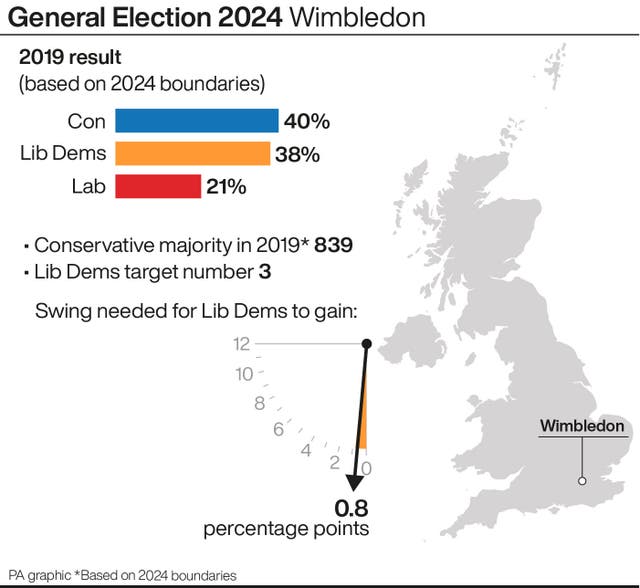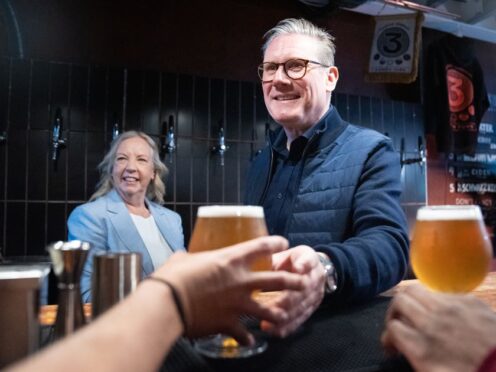London is one of the few areas of the country where Labour is already in a very strong position, holding more than two-thirds of seats in the capital, and the election could see the party advance even further to make a string of gains.
A redrawing of boundaries means London now has 75 constituencies, up from 73 in 2019, and had the last election been fought on these new boundaries it is calculated the Labour would have won 52 seats, the Conservatives 20 and the Liberal Democrats three.
Notional results for the 2019 election based on the 2024 boundaries have also been calculated, in order to determine the scale of the challenge facing candidates this time, and it is these notional majorities that are used below.
Labour’s top target in London is Chingford & Woodford Green, where the Conservative candidate is former Tory leader and one-time Work & Pensions Secretary Sir Iain Duncan Smith.
Sir Iain is defending a tiny majority of 1,604 and a swing of 1.5 percentage points is all it would take for the seat to change hands, but Labour’s performance might be affected by its decision to select Shama Tatler as its candidate rather than Faiza Shaheen, who fought the seat for Labour in 2019 and who is standing this time as an Independent.

Next on Labour’s list in London is the newly-created seat of Eltham & Chislehurst, where the Tories are defending a notional majority of 3,444, and Chipping Barnet, where the Tory candidate is former Northern Ireland Secretary Theresa Villiers (2019 majority: 4,209) and which the Conservatives have won at every general election since the seat was created in 1974.
Cities of London & Westminster, a seat that includes within its boundaries the Houses of Parliament and Downing Street, has an even longer history of Tory MPs, having been first won by the party in 1950 – but at this election, it is one of Labour’s key targets in the capital, where the party is hoping to overturn a Conservatives majority of 5,976.
Labour came close to taking Uxbridge & South Ruislip in June 2023, in a by-election triggered by the resignation of its MP and former prime minister Boris Johnson.
The defeated Labour candidate in that contest, Danny Beales, is back for a rematch with the person who beat him in 2023, Tory candidate Steve Tuckwell, in a seat won by Mr Tuckwell at the by-election by just 495 votes.
Hendon is one of a number of so-called “bellwether” seats in London, which means the result in the constituency has a habit of matching the overall result of the general election.
The Tories are defending a majority of 3,661 in Hendon, which has been a bellwether since 1997, 6,629 in Finchley & Golders Green, a bellwether also since 1997, and 8,987 in Harrow East, which has been a bellwether since 1979.
The Liberal Democrats came second in Finchley & Golders Green in 2019, but this reflected the unique circumstances of that particular election – which saw former Labour MP Luciana Berger stand as the Lib Dem candidate – and the seat is more plausibly a Labour target this year.
A total of nine seats being defended by the Conservatives in London would fall to Labour on a swing of up to 10 percentage points, comprising all of the seats listed above plus Chelsea & Fulham.
If Labour does exceptionally well in the capital, constituencies such as Croydon South (2019 Tory majority: 13,408), Bromley & Biggin Hill (14,380) and Ruislip, Northwood & Pinner (15,810) might even be in play.
It is not just Labour that the Conservatives have to worry about in London, however.

The capital is home to Carshalton & Wallington, the Lib Dems’ number one target in the whole of the country, which the party narrowly failed to win in 2019 and where the Tories are defending a majority of just 629.
London is also home to the Lib Dems’ number three nationwide target, Wimbledon, where they are hoping to overturn a similarly wafer-thin Conservative majority of 839.
While the Lib Dems held Carshalton & Wallington from 1997 to 2019, they have never won Wimbledon and victory here on July 4 would make history.
The one other plausible target for Sir Ed Davey’s party in London is Sutton & Cheam, where the Tories are defending a majority of 8,351 and which the Lib Dems held from 1997 to 2015.
The safest Conservative seat in the capital is probably Hornchurch & Upminster, where the Tory candidate Julia Lopez – currently Minister of State for Media & Tourism – is defending a majority of 21,735 and which needs a huge swing of 21.3 percentage points for Labour to win.
Two other Tory defences in London have majorities of more than 20,000 – Old Bexley & Sidcup and Orpington – and if either of these were to fall to Labour, the Conservatives would be having a truly atrocious election.
Elsewhere in the capital, former Labour leader Jeremy Corbyn is standing as an independent in Islington North, a seat he has won for his former party at every general election since 1983 and where he now faces a challenge from the official Labour candidate, Praful Nargund.
Labour leader Sir Keir Starmer faces 11 other candidates in his seat of Holborn & St Pancras, making it one of the most contested constituencies in the country.
The most contested of all is Rishi Sunak’s seat of Richmond & Northallerton in North Yorkshire, where the prime minister is up against 12 opponents.
Lib Dem leader Sir Ed Davey faces seven other candidates in his London seat of Kingston & Surbiton.
All notional majorities and swings mentioned above have been compiled by professors Colin Rallings and Michael Thrasher of the University of Plymouth, on behalf of BBC News, ITV News, Sky News and the PA news agency, and will be used as the basis for reporting the gains and losses at the General Election.
